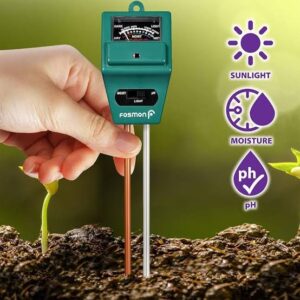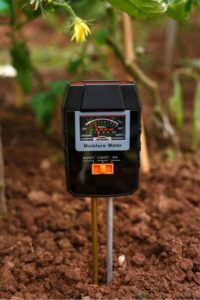Back to: Botany 300 Level
Hello, Afrilearn Scholar! I hope you’re doing great today and ready for another exciting lesson! Today, we’re going to focus on an important topic in plant ecology—measuring soil pH and moisture content. These two factors play a huge role in how plants grow and thrive, and understanding them is key to managing healthy ecosystems, especially in farming, forests, and even gardens. I’m going to walk you through what these terms mean and how we can measure them in the field. Let’s jump in!
Measuring soil pH and moisture content
What is Soil pH?
Soil pH refers to how acidic or alkaline the soil is, and it’s measured on a scale from 0 to 14. A soil pH of 7 is considered neutral—neither acidic nor alkaline. Soils with a pH lower than 7 are acidic, while those with a pH higher than 7 are alkaline.
Soil pH is crucial because it affects how plants take up nutrients from the soil. Some plants thrive in acidic soils, while others prefer alkaline soils. For instance, crops like maize and cassava in Nigeria generally do well in neutral to slightly acidic soils, whereas blueberries prefer very acidic conditions.

Why is Soil pH Important?
The pH of the soil affects many things:
Nutrient Availability: Certain nutrients become available to plants only when the soil is at the right pH. For example, phosphorus is most available to plants in slightly acidic to neutral soil. If the pH is too low (too acidic) or too high (too alkaline), plants may struggle to absorb nutrients.
Soil Microorganisms: Soil microbes, which help decompose organic matter and break down nutrients for plants, also have preferences for certain pH levels. Some beneficial microbes may not thrive in soil that’s too acidic or too alkaline.
Plant Growth: Many plants have a narrow pH range in which they grow best. For example, rice grows best in slightly acidic to neutral soils, while cabbage and carrots thrive in more neutral soils.
How to Measure Soil pH
To measure soil pH, there are several methods, but we’ll look at the most common ones used in the field.
Method 1: Using a Soil pH Meter
A soil pH meter is a simple tool that directly measures the pH of the soil. To use it:
Collect a soil sample from the area you want to test. Make sure to take samples from different parts of the area for a more accurate reading.
Insert the probe of the pH meter into the soil.
Read the pH value displayed on the meter. It will typically give a number between 0 and 14, which indicates how acidic or alkaline the soil is.
Method 2: Using pH Test Strips or Kits
Another common method is using pH test strips or a liquid test kit. These kits typically come with a solution that changes colour based on the soil’s pH. To use them:

Mix a soil sample with water (usually distilled water).
Add the testing solution or dip the pH strip into the soil-water mixture.
Compare the colour of the solution or strip to a provided colour chart, which will tell you the pH.
What is Soil Moisture Content?
Soil moisture refers to the amount of water present in the soil. It is a critical factor for plant growth, as plants need adequate moisture to absorb nutrients and perform vital processes like photosynthesis.
Too much moisture can lead to waterlogging, which deprives plant roots of oxygen, while too little moisture causes drought stress, where plants can’t access enough water to survive.
Why is Soil Moisture Important?
Plant Watering: Soil moisture directly affects how often plants need to be watered. Crops like yams in Nigeria require plenty of water during their growing season, while cacti and other drought-resistant plants can survive with minimal water.
Nutrient Uptake: Water is essential for dissolving nutrients in the soil so that plant roots can absorb them. Without enough moisture, even if nutrients are present in the soil, plants won’t be able to take them up efficiently.
Plant Growth: Moisture content influences seed germination, root development, and overall plant health. If plants don’t have enough water, they will not grow properly and may even die.
How to Measure Soil Moisture Content
There are different methods to measure soil moisture, but we’ll focus on two common ones.
Method 1: Using a Soil Moisture Meter
A soil moisture meter is another handy tool that measures the water content in the soil. It works similarly to a pH meter:
Insert the probe of the moisture meter into the soil.
The meter will show a reading that typically ranges from dry to wet. Some meters may give a numerical value, with higher numbers indicating more moisture.

Method 2: The Hand Test (Simple but Effective)
If you don’t have a moisture meter, you can test the soil’s moisture content by using your hands:
Take a handful of soil and squeeze it tightly.
Check how much water is in the soil. If water drips out, the soil is too wet. If the soil stays together in a clump without crumbling, it has adequate moisture. If the soil falls apart easily, it’s too dry.
Why Are Soil pH and Moisture Content Important Together?
Both soil pH and moisture content are essential for plants to grow well. If the soil is too acidic or alkaline, plants might not be able to take up water properly, even if the moisture is there. Similarly, plants in waterlogged soils might suffer from nutrient deficiencies despite having access to plenty of moisture. By measuring both, you get a complete picture of the growing conditions for plants.
Summary
In this lesson, we’ve learned about two important soil properties: pH and moisture content.
Soil pH determines how acidic or alkaline the soil is, influencing nutrient availability and plant growth. We measure it using pH meters or test kits.
Soil moisture is the amount of water present in the soil, crucial for nutrient uptake and plant health. We measure it using moisture meters or the simple hand test.
By understanding and measuring these properties, we can better manage soil for farming, conservation, and gardening, ensuring plants grow in the best conditions possible.
Evaluation
- What is soil pH, and why is it important for plant growth?
- How can you measure soil pH using a pH meter or test strip?
- Why is soil moisture content crucial for plant health?
- How do you measure soil moisture using the hand test?
- Why is it important to measure both soil pH and moisture content together?
Great job today, Afrilearn scholar! You’ve just learned how to measure two key factors that affect plant growth—soil pH and moisture content. These skills are essential whether you’re managing a garden, farming, or studying the environment. Keep practicing, and soon you’ll be able to apply this knowledge to real-world scenarios! I’m so proud of your progress, and I can’t wait to see you in the next lesson. Keep up the amazing work!
